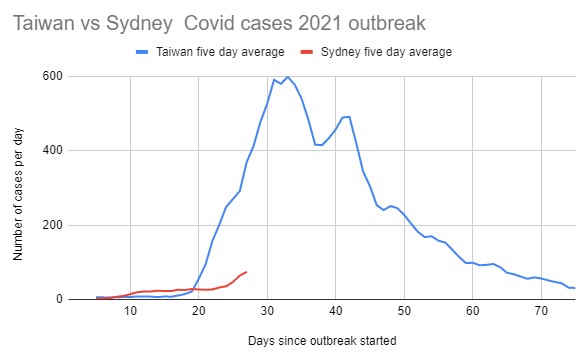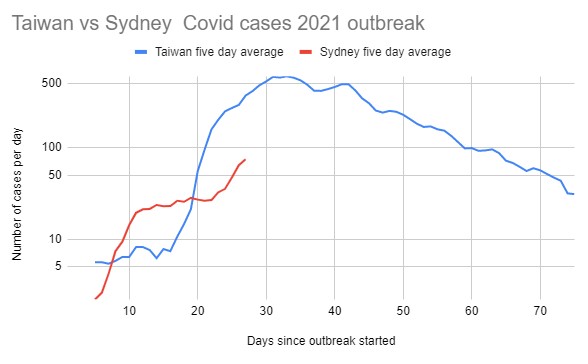As Sydney grapples with the Delta virus and our second week of lockdown, I thought a look at Taiwan might be instructive. Taiwan is nearly two months ahead of Sydney with its first real Covid19 outbreak of the whole pandemic. And while everyone is looking at Melbourne, other places in the world are less well known. While I hope the Sydney outbreak doesn’t get as bad as Taiwan, theirs is close to being under control now, just under three months after it started.
Reading this article from 21 May almost seems like reading about Sydney. Does any of this sound familiar?
After rapidly imposing world-leading infection control measures, Taiwan slowly began to let down its guard last summer. Crowds of thousands of people were allowed to return to concerts, baseball games and religious festivals. Large meals and family gatherings became increasingly common, and masks became rarer as months passed with no local infections.
“Last year, we started to kind of go out, but deal with it in a careful way,” says Freddy Lim, a rockstar turned lawmaker who represents Wanhua in Taiwan’s legislature. “But this year, I think we forgot the part about being careful.”
But, lax adherence to the island’s safety protocols also played a role. Taiwan’s current community outbreak began in April with cargo plane crews at the Novotel at Taipei’s Taoyuan International Airport. The hotel violated COVID-19 rules by housing quarantined flight crews and non-quarantine guests in the same building. In mid-April, Taiwan also lowered quarantine requirements for non-vaccinated flight crews from five days to just three.
The other major reason that COVID-19 has spiked so quickly in Taiwan is that the virus found virgin immune territory. Very few people have been exposed and thus very few have antibodies. Taiwan’s vaccination rollout has also been almost non-existent.
At the end of April Taiwan had a case or two (Alpha variant) escape from Hotel quarantine. On 15 May they had 185 positive cases, and moved into (their category) of Level 3 lockdown. The highest day of cases was 22 May, with 723, and on 12 July, there were 23 positive local cases (9 of whom had been in isolation for their whole infectious period). In this outbreak so far there have been around 14,000 cases and more than 700 deaths.
This article describes the restrictions, which were extended a few times, are being slightly relaxed from 12 July, and now scheduled to finish on 26 July.
- Wearing of masks at all times outdoors
- Indoor gatherings limited to five people
- All places of business and public venues are shuttered, with the exception of essential services, police departments, hospitals, and government buildings
- Masks and social distancing required at all businesses or venues that remain open
- In areas where community transmission has taken place, residents are restricted to a set perimeter and must submit to COVID-19 testing
At the end of June, they also had a small Delta cluster which was controlled quite quickly, given the already existing restrictions.
These graphs of cases are scary given how high it eventually got, from the perspective of our current NSW outbreak. 

On a logarithmic scale, a straight line means we are experiencing exponential growth (or decline). In Sydney, the straight line took a sharp turn upward about a week ago, as the outbreak took hold in south west Sydney. But it is still not quite as steep as the worst days in Taiwan, and ultimately, I think this is cause for optimism for those of us in Sydney.
Despite getting to an average peak of around 600 cases per day, Taiwan has gradually wrestled the outbreak into submission. The Taiwan restrictions seem to be slightly stronger than NSW’s restrictions, with essential retail being more narrowly defined, and more support for foreign workers while they are not working. They’ve also done mass testing at major sites with exposure (eg wholesale food markets), similar, but not the same as high risk local government area workers being asked to test before leaving the area. I’m not an epidemiologist, and many others with more knowledge than me have done simulations on the specifics of Sydney. But Taiwan is quite a positive example, to me. While it has taken them a while to get their outbreak under control, we have acted faster initially, and they got there eventually.
Links
Melbourne University has released a new model of opening up for Australia, you can play with it here (and I’ll probably have a closer look in my next post). Here’s what they say about it:
Last week, Prime Minister Scott Morrison announced the Federal Government’s four-phase plan. Phase 1 involves vaccinating, preparing and piloting opening up, before moving onto Phase 2’s post-vaccination plans, through Phase 3 and onto Phase 4 when life becomes relatively normal.
It’s the transition to Phase 2 that’s critical – as it’s supposedly underpinned by a vaccination coverage threshold which means Australia can open up its borders to international arrivals without quarantine.
But, with respect, this is the wrong way to look at it.
Vaccination coverage is very important, but so too are a number of other factors; the expected number of infected people arriving per day, the pre-departure requirements of vaccination and polymerase chain reaction (PCR) testing of travellers to Australia, the policy responses we have (do we continue to aggressively suppress the virus, or do we allow high numbers of infections before we use lockdowns?), and the reproductive rate (known as the R0) or infectiousness of the virus.
…
The decision as to what risk to tolerate is not ‘a scientific number’ for two reasons.
You cannot look at vaccination coverage alone, but rather determine the risk we are prepared to live with and find the settings that keep within that risk. On top of this, the tolerable risk is a societal and political decision.
And here is some more information about Long Covid from a prospective study in Norway (which means that they started with everyone infected with Covid, and then kept track of them). Adding to the view that Covid is a nasty disease that it is worth trying to avoid, even if you are quite young:
Long-term complications after coronavirus disease 2019 (COVID-19) are common in hospitalized patients, but the spectrum of symptoms in milder cases needs further investigation. We conducted a long-term follow-up in a prospective cohort study of 312 patients—247 home-isolated and 65 hospitalized—comprising 82% of total cases in Bergen during the first pandemic wave in Norway. At 6 months, 61% (189/312) of all patients had persistent symptoms, which were independently associated with severity of initial illness, increased convalescent antibody titers and pre-existing chronic lung disease. We found that 52% (32/61) of home-isolated young adults, aged 16–30 years, had symptoms at 6 months, including loss of taste and/or smell (28%, 17/61), fatigue (21%, 13/61), dyspnea (13%, 8/61), impaired concentration (13%, 8/61) and memory problems (11%, 7/61). Our findings that young, home-isolated adults with mild COVID-19 are at risk of long-lasting dyspnea and cognitive symptoms highlight the importance of infection control measures, such as vaccination.
And finally, some lessons from Melbourne for Sydney from Melbourne ABC radio host Rafael Epstein:
We desperately need to know more about how this outbreak is being handled, starting with these questions.
- Who is defined as a close contact?
- What work is NSW Health doing with business on “essential workers”?
- What is “essential” shopping?
- How do we better share information?
In Victoria, we wasted too much media time focusing on who employed the security guards and didn’t spend nearly enough time on what the health department failed to do. It is a relief that Berejiklian is not facing the same illogical and fact-free questions directed at Dan Andrews. But we urgently need answers to detailed questions because if my friends in Sydney are in trouble then we are all in trouble.
Life glimpses
In my French conversation class this week, one of the topics was whether the confinement in Sydney had affected us very much. Apart from the obvious fact that we were all talking on line, our first answer was not a huge amount.
But for me I realised the impact is more than I first thought – I’ve had three different theatre performances cancelled since the current wave in Sydney began, including Hamilton, which I had very much been looking forward to, as well as a planned break down on the South Coast with friends. Very much the problems of the privileged! As one of my friends said this week, my day to day life hasn’t changed all that much, it is more that the possibilities have just closed in a bit more for the foreseeable future.
On the plus side, I’ve got back my exercise routine, I’ve been back to one of my favourite bike rides (Bradley’s Head at sunset), my nearby park finished their renovations just in time for lockdown, and my bread recipe is making a comeback.
Bit of beauty
In honour of my focus on Taiwan today, a picture from my trip there in 2018. We had a lot of fun playing with the reflections from the rain during the day and took way too many pictures in this spot. And if I’m honest, the chance to look at some overseas pictures was another reason to write about Taiwan today.


Taiwan one of the most densely populated places on earth. Australia is at the other end of the spectrum. So I don’t see how the two are in any way comparable, proximity to others being the vector for spread of Covid.
Thanks, I’ve not checked the detailed comparison, but Australia is one of the most urbanised countries around, actually slightly more urbanised than Taiwan, so more comparable than you might think.
National population density is a pretty poor guide to the impact of COVID-19, as this chart shows: https://ourworldindata.org/grapher/covid-19-death-rate-vs-population-density
Studies that relate COVID-19 spread to population density are focused on local density (e.g. US county population density). Given the high urbanisation in Australia, I would suggest that Australia and Taiwan are quite comparable.
By the way, Taiwan is not on that chart but would be a tad “south-east” of South Korea. Slightly higher population density and slightly lower death rate.
I agree the population density by nation is spatially silly, certainly as far as countries like Australia are concerned. However there is quite likely good correlation, at say SA1 level or equivalent, between population density and potential for spread of Covid. I don’t know how we would compare with Taiwan at that level.
In terms of this period of “confinement”, I am managing the lockdown in a similar manner to 2020, just a little more annoyed and more directly affected. However, and not unrelated, I am nominating my daughter for the most adverse personal effects of the current Sydney lockdown:
– Her new yoga/Pilates business was shut down less than two weeks after opening
– Material constraints on her grandmother’s funeral
– Limitations on visiting her newborn niece
– Serious doubts about her August wedding proceeding
– Performance of “Hamilton” she had tickets for cancelled
Deep sympathy for anyone who outdoes her.